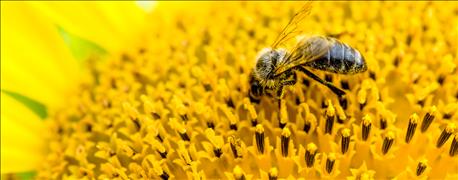April 3, 2019

A new list of best management practices to protect bees and other pollinators in and around cornfields is available from the National Corn Growers Association, in partnership with the Honey Bee Health Coalition.
At roughly 92 million acres, field corn covers more land than any other row crop in the country, and in the Midwest Corn Belt, corn often makes up to 40% of the landscape or more. The BMPs presented in the NCGA’s new guide identify potential effects of agricultural practices on bees at each stage of production and recommend ways to mitigate those impacts.
The digital publication showcases specific strategies such as reducing dust and drift while planting pesticide-treated seed.
“While corn does not rely on honey bees for pollination like some crops, bees depend on neighboring plants for forage,” said Nathan Fields, NCGA vice president of production and sustainability. “As good stewards of the land, corn growers can follow these BMPs to help protect honey bee health, ensuring productive agricultural systems for all.”
Corn farmers who rotate with soybeans could also see added benefit from their pollinator stewardship because bees can increase soybean yields by up to 18%, according to a 2005 study.
Planting time is a key time for farmers to map out a bee-friendly strategy, and the NCGA Best Management Practices guide features season-long BMPs for growers. It also contains information for beekeepers who often work in concert with farmers on healthy bee populations.
A summary of key practices includes:
Communicating about beehive locations, crop management practices, and coordinating with beekeepers.
Checking extension recommendations, considering multiple strategies for pest control, and verifying in-field needs before applying pesticides.
Planting and preserving flowering plants in non-crop areas.
�“Making adjustments in how we spray and what time of day we spray can yield positive results for pollinators,” Roger Zylstra, a Lynnville Iowa farmer and chairman of NCGA’s Stewardship Action Team said. “And better communications between farmers and beekeepers to reduce bee exposure to pesticides in the spring and summer can provide big benefits.”
To date, the NCGA and two other Honey Bee Health Coalition member organizations – the U.S. Canola Association and United Soybean Board – have worked with the Coalition to develop and distribute BMP guides specific to corn, canola and soybean.
The Honey Bee Health Coalition brings together beekeepers, growers, researchers, government agencies, agribusinesses, conservation groups, manufacturers, and consumer brands to improve the health of honey bee populations both generally and around production agriculture by addressing hive pests and disease, forage and nutrition and exposure to crop pesticides.
Each set of best practices was developed by an expert team of agronomists, entomologists, beekeepers, extension and regulatory agents and reviewed by farmers, crop consultants, agribusiness representatives, retail suppliers, conservation NGOs and other stakeholders.
Source: NCGA, which is solely responsible for the information provided and is wholly owned by the source. Informa Business Media and all its subsidiaries are not responsible for any of the content contained in this information asset.
You May Also Like




